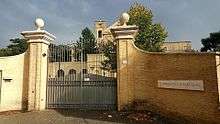Pontifical Institute of Sacred Music
The Pontifical Institute of Sacred Music (Italian: Pontificio istituto di musica sacra; Latin: Pontificium institutum musicae sacrae) is an institution of higher education of the Roman Catholic Church specifically dedicated to the study of church music. It is based in Rome, Italy, located in the former Pontifical Abbey of St Jerome-in-the-City.

History
The Institute was established by Pope Pius X in 1910 as the "School of Sacred Music".[1] The institute was established as a body dedicated to teaching and performing "sacred music".[2] The school opened in 1911. In July 1914, the school was declared a Pontifical Institution and was granted the power to confer academic degrees.
On 23 September 1914, newly elected Pope Benedict XV referred to the institute as part of the legacy left to him by his predecessor saying he would support and promote it in the best way possible. The following month, he assigned the Palazzo di Sant'Apollinare as the residence of the school, relocating it from via del Mascherone.[3]
Pope Pius XI's Motu Proprio, Ad musicae sacrae (22 November 1922) confirmed the connection between the institute and the Apostolic See.[4]
With the apostolic constitution Deus scientiarum Dominus of 1931, the institute took its present name and was included among the pontifical academic institutes. The institute moved to the former Pontifical Abbey of St Jerome-in-the-City in 1983.
Courses offered
The Institute grants the following degrees in sacred music: Bachelor (3 years), Licentiate (2 years) and a Doctorate. The degrees are offered with one of the following foci: Gregorian chant, composition, choral direction, musicology, pipe organ and pianoforte.
Instruction in Italian is offered in harmony, counterpoint, fugue, composition, acoustics, music history and analysis, musicology, bibliography, research methods, ethno-musicology, editing of music, notation, Gregorian chant, liturgics, piano, pipe organ, score reading, continuo (figured bass), keyboard improvisation, choral conducting and Latin.
Students of note
- France Ačko
- Fabrizio Barchi
- Lourdino Barreto
- Miguel Bernal Jiménez
- Theodore Marier
- Armando Pierucci
- Robert Skeris